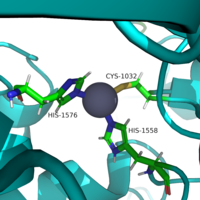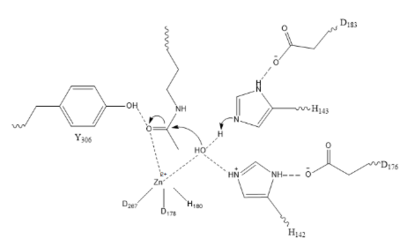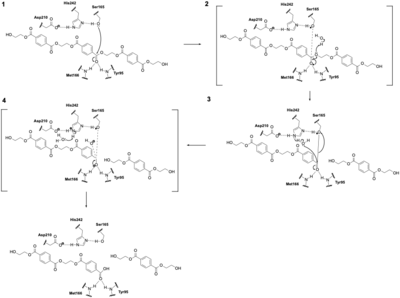User:Asif Hossain/Sandbox 1
From Proteopedia
| Line 12: | Line 12: | ||
==Structural Highlights== | ==Structural Highlights== | ||
| + | The HDAC8 comprises a single α/β domain that is composed of an eight-stranded parallel <scene name='81/811084/Beta_sheets/4'>β-sheet</scene> sandwiched between 13 <scene name='81/811084/Alpha_helicesv2/3'>α helices</scene>(&). The HDAC8 consists of 377 amino acids, half of which are contained in the secondary structure elements and the other half are contained in loops that link the various elements of the secondary structure. The residues forming active site and catalytic machinery of the enzyme is found in the loops from the C-terminal ends of the strands of the core β-sheet. | ||
| + | |||
===Zinc Ion=== | ===Zinc Ion=== | ||
The pentacoordinated Zn2+ ion involved in the metalloenzyme catalysis is tethered to the protein through interactions with Asp267, Asp178, and His180. This positions the metal ion to favorably interact the catalytic water and acetylated lysine substrate. ** The zinc ion lowers the pKa of a water proton that makes the water more nucleophilic. Besides increasing the nucleophilicity of the zinc, the zinc like also facilitates the deacetylation process by reducing the entropy of the reaction by binding both the nucleophile and the substrate and polarizing the carbonyl of the acetyl-lysine and stabilizing the transition state. | The pentacoordinated Zn2+ ion involved in the metalloenzyme catalysis is tethered to the protein through interactions with Asp267, Asp178, and His180. This positions the metal ion to favorably interact the catalytic water and acetylated lysine substrate. ** The zinc ion lowers the pKa of a water proton that makes the water more nucleophilic. Besides increasing the nucleophilicity of the zinc, the zinc like also facilitates the deacetylation process by reducing the entropy of the reaction by binding both the nucleophile and the substrate and polarizing the carbonyl of the acetyl-lysine and stabilizing the transition state. | ||
Revision as of 22:17, 7 April 2019
Contents |
Histone Deacetylase 8 (HDAC 8)
Introduction
Histone deacetylase 8 (HDAC8) is an enzyme that plays a role in controlling gene expression in Homo sapiens. Specifically, HDAC8 catalyzes the removal of an acetyl group off of the ε-amino-lysine sidechain of N-terminal core of histone proteins. Histones consist of eight monomers to form an octomer complex. In addition, histones are highly basic and have a large positive charge. Since DNA is negatively charged, histones tightly interact with DNA. This prevents transcription factors from accessing DNA, thus decreasing gene expression. Histones regulate gene expression without altering the sequence of DNA making histones epigenetic regulators. This interaction between DNA and histones can be disrupted by Histone acetyltransferase (HAT). HATs catalyzes the addition of an acetyl group onto a histone. The hydrophobicity of the acetyl group prevents the interaction between DNA and histones. This allows transcription factors to access the DNA to increase gene expression. HDAC8 reverses this reaction by catalyzing the removal of these acetyl groups By removing the acetate, the reclaimed positive charge on the lysine sidechain is able to interact with the negative charge on the DNA. As a result, DNA will bind more tightly to the histone protein, repressing transcription and expression.
| |||||||||||
Relevance
Besides controlling the gene regulation through deacetylation of histones, HDAC 8 also regulates the post-transcriptional acetylation status of many non-histone proteins, including transcription factors, chaperones, hormone receptors and signaling molecules. Thus, it has influences on protein stability, protein-protein interactions and protein-DNA interactions. HDAC 8 can therefore affect the regulation of cell proliferation and cell death. These processes are typically being altered in cancer cells and that makes HDAC enzymes an interesting potential target for cancer drugs. HDAC inhibitors have been shown to be promising cancer drug agents in prior research as the HDAC inhibitors cease tumor growth in cancer cells by either making them differentiate or undergo apoptosis. One way, the HDAC inhibitors ceases tumor growth is by the reactivation of the transcription factor, RUNX3, a known tumor suppressor. HDACi increases the acetylation of the protein and as the stability of RUNX3 is dependent on the acetylation status of the protein, the increased acetylation or HDAC inhibition will enhance the protein stability, causing an increase in the anti-tumorous properties of the protein. A number of HDAC inhibitors have been purified from natural sources or synthesized and HDAC inhibitors can be structurally grouped into at least four classes: hydrox-amates, cyclic peptides, aliphatic acids and ben-zamides. The Vorinostat(within the hydrox-amates class) has been FDA-approved for treatment of cancer. The hydrox-amate HDAC inhibitors inhibits the HDAC 8 by competition inhibition by making a favorable bidental interaction with the Zn2+ Ion and makes strong interactions with the Asp101.
References
1. Whitehead, L., Dobler, M. R., Radetich, B., Zhu, Y., Atadja, P. W., Claiborne, T., ... & Shao, W. (2011). Human HDAC isoform selectivity achieved via exploitation of the acetate release channel with structurally unique small molecule inhibitors. Bioorganic & medicinal chemistry, 19(15), 4626-4634.



